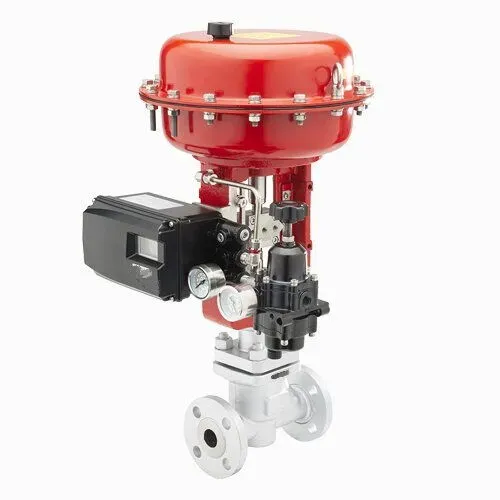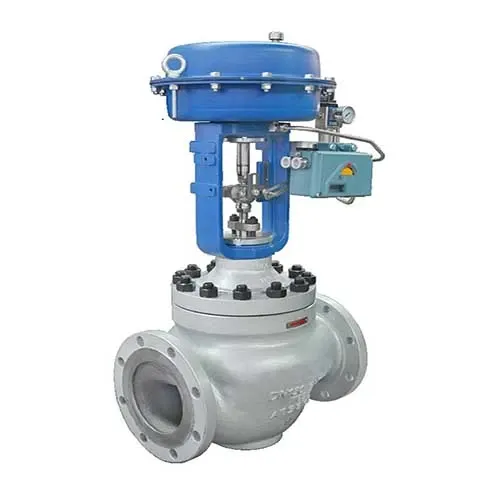In the world of industrial fluid control, selecting the right type of control valve is crucial to ensuring operational efficiency, safety, and long-term durability. Among the many types of control valves, the Single Seat Globe Control Valve and the Cage Guided Globe Control Valve are two of the most widely used designs. Each valve has its unique characteristics, making it more suitable for certain applications. This article explores the differences between these two types of control valves, including their definitions, applications, structural features, and advantages.
The Single Seat Globe Control Valve is a type of valve that is designed to control the flow of liquids, gases, or steam. The valve trim (such as the plug and seat) is interchangeable within the valve body, offering flexibility for a variety of process control applications. The single-seat design consists of a valve body with a single seat, and the trim can be modified by replacing components to accommodate different operating conditions, such as varying flow rates and fluid characteristics.

The Single Seat Globe Control Valve is one of the most commonly used valve types in industries requiring precise flow control. It is particularly well-suited for strictly sealed shut-off applications, where leak-tight performance is crucial. The primary function of this valve is to control flow rates by adjusting the size of the plug and seat ring. By altering the geometry of the trim components, such as the plug's shape or the seat ring's design, users can achieve the desired flow characteristics for specific fluids.
Single-seat valves are versatile and are typically used in both liquid and steam services. They are commonly found in industries like:
Chemical processing
Power generation
Oil and gas
Water treatment
Their adaptability makes them a go-to solution for a broad range of process control applications.
The structural design of a single-seat globe valve is relatively simple and straightforward. The valve body houses a single trim set, consisting of a plug and seat ring. The plug is connected to a stem, which moves up and down to control the flow. The valve's body is generally constructed from a durable material, such as carbon steel, stainless steel, or other alloys suited for high-pressure or high-temperature environments.
One notable feature of single-seat globe control valves is their increased unbalanced force under high-pressure conditions. Since the valve typically employs a single plug, the high-pressure fluid creates a significant unbalanced force on the plug, which can reduce the valve's sealing efficiency. As a result, the allowable pressure drop in single-seat globe valves is lower than that of valves with balanced trim designs. This can limit their application in certain high-pressure process control systems.
Simple structure and ease of maintenance.
Effective for tight shut-off and flow regulation.
Flexibility in adjusting the trim to suit different fluid characteristics.
Widely applicable in liquid and steam services.
Unbalanced forces under high pressure can affect performance and sealing.
Not as suitable for applications with high-pressure drops.
The Cage Guided Globe Control Valve features a more complex design, with a cage structure that supports the valve plug. The plug's motion is guided within the cage, resulting in a more controlled and precise flow regulation. The trim components in a cage-guided control valve are interchangeable, allowing the valve to be customized for various fluid characteristics and operating conditions. This design is optimized for applications where high-pressure drops, cavitation, and noise are concerns.
Cage-guided control valves are specifically engineered to address these challenges, making them ideal for high-pressure systems where cavitation can cause damage to the valve and lead to performance degradation.

Cage-guided control valves are used in a wide range of industrial applications, particularly those involving high-pressure or high-temperature fluids. They are commonly found in industries such as:
Power plants
Chemical manufacturing
Oil refining
Natural gas processing
Due to their ability to handle high-pressure drops and mitigate cavitation and noise, cage-guided valves are suitable for critical process control applications where precision and reliability are essential.
The temperature range for cage-guided valves varies depending on the type of seat used:
With a metal seat, the temperature range is from -196°C to +538°C.
With a soft seat, the range is from -45°C to +200°C.
This makes cage-guided valves highly versatile and capable of performing in extreme operating conditions.
The cage-guided control valve design features a cage that surrounds the plug, guiding its motion as it adjusts the flow. This cage structure significantly reduces the unbalanced forces on the valve plug, which is especially important in high-pressure applications. The fluid pressure acting on the plug is counterbalanced, allowing the valve to operate more smoothly and with greater precision.
Cage-guided valves can also feature balance ports, which further reduce unbalanced forces. The use of twin-seat or single-seat cage-guided valves offers flexibility in terms of leakage requirements and flow characteristics.
The design of the valve body and cage structure also helps to address cavitation and noise. By using special trim components, such as cage and plug designs, these valves can reduce the effects of cavitation, which can occur when the fluid pressure drops below its vapor pressure. Cavitation can cause damage to valve components and reduce performance over time. Cage-guided valves can also mitigate the noise generated by high-pressure fluid flows, ensuring quieter operation in noisy industrial environments.
Superior performance under high-pressure conditions due to balanced plug design.
Excellent at mitigating cavitation and noise in high-pressure services.
Greater precision in flow control, especially with adjustable trims.
Suitable for a wide range of fluids and extreme temperature conditions.
Flexibility in adjusting trim components to meet different process control needs.
More complex design and higher cost compared to single-seat valves.
May require more maintenance and expertise to handle the intricate trim components.
When choosing between a single-seat globe valve and a cage-guided globe valve, several factors need to be considered, including the operating environment, fluid characteristics, pressure requirements, and desired flow control precision.
|
Feature |
Single Seat Globe Valve |
Cage Guided Globe Valve |
|
Design |
Simple structure with a single seat and plug |
Complex cage structure with a guided plug |
|
Flow Control |
Basic flow regulation, effective for moderate pressure conditions |
Precise flow control with high-pressure capabilities |
|
Pressure Drop |
Handling Limited to moderate pressure drops |
Excellent for handling high-pressure drops |
|
Cavitation & Noise |
Not ideal for cavitation or high-noise conditions |
Effective at reducing cavitation and noise |
|
Applications |
Liquid and steam services, moderate pressure |
High-pressure, high-temperature, and critical applications |
|
Advantages |
Simple, cost-effective, easy to maintain |
Highly precise, durable, suitable for extreme conditions |
|
Limitations |
Unbalanced forces under high pressure |
Higher complexity and maintenance requirements |
The choice between a single-seat globe valve and a cage-guided globe valve largely depends on the specifics of your application. For moderate-pressure applications that require simple flow regulation and tight shut-off, the single-seat globe valve is a reliable and cost-effective option. However, for high-pressure environments, or where cavitation and noise are a concern, the cage-guided globe valve provides superior performance, precision, and reliability.
In general, single-seat globe valves are more suitable for standard, low-pressure applications with less complex flow requirements, while cage-guided globe valves are better suited for demanding, high-pressure, and high-temperature applications that require precise control, noise reduction, and resistance to cavitation.
By understanding the distinct features and advantages of each valve type, you can make an informed decision that best meets your process control needs, optimizing both performance and cost-efficiency in your operations.
